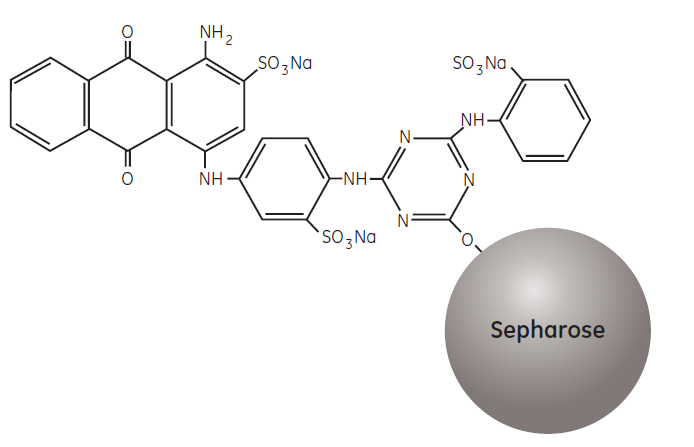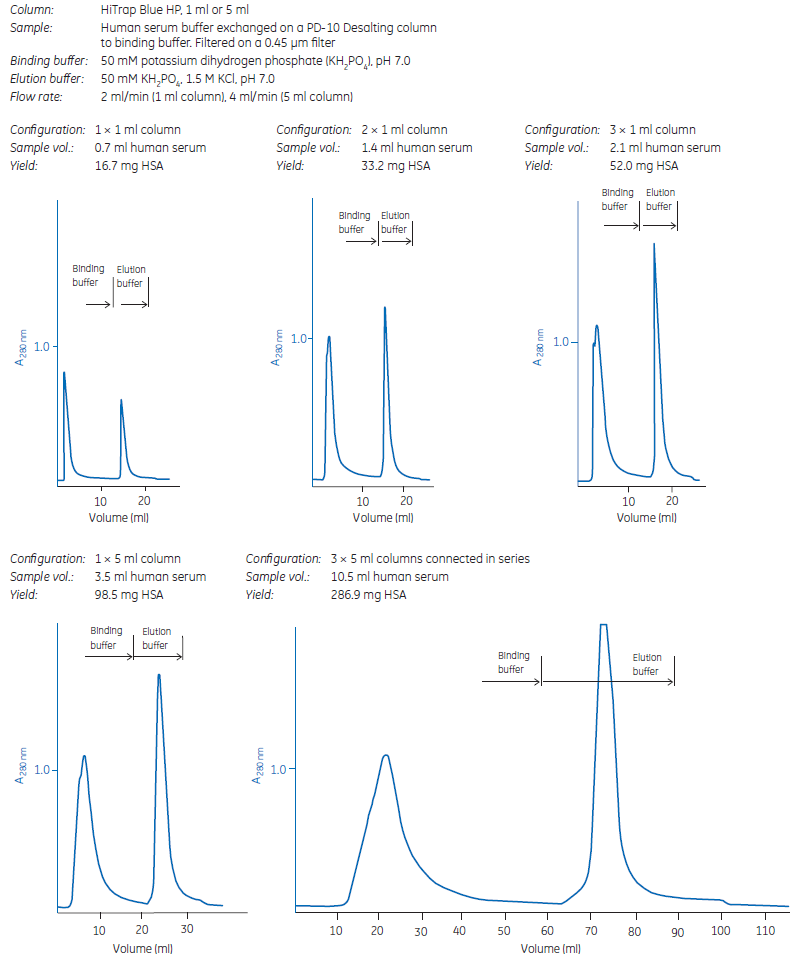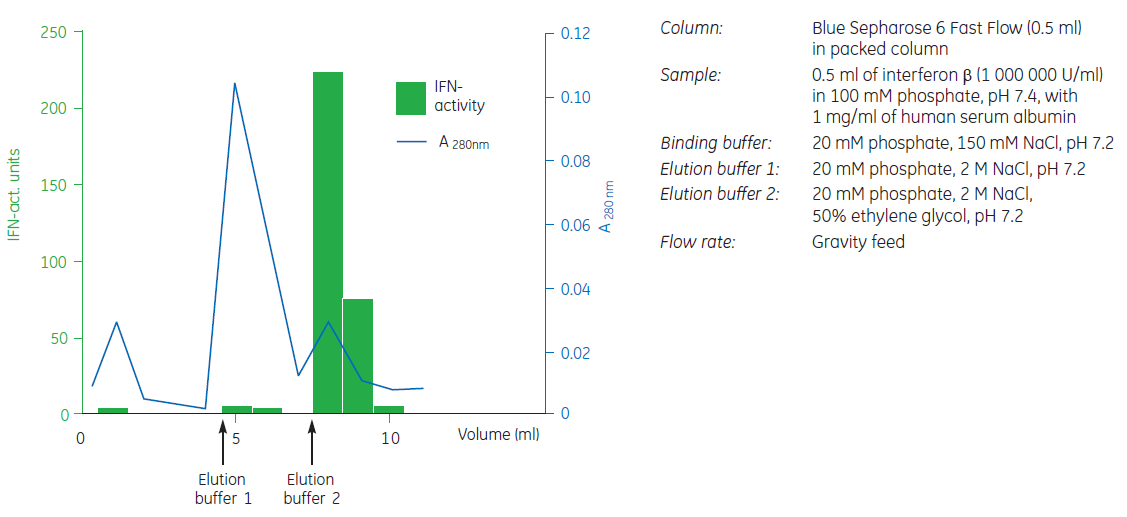Purification or Removal of Albumin
Blue Sepharose High Performance, Blue Sepharose 6 Fast Flow, Capto Blue, Capto Blue (high sub)
Albumin binds to Cibacron Blue F3G-A, a synthetic polycyclic dye that acts as an aromatic anionic ligand binding the albumin via electrostatic and/or hydrophobic interactions. Similar interactions are seen with coagulation factors, lipoproteins and interferon. Cibacron Blue
F3G-A is linked to Sepharose to create Blue Sepharose AC media (Figure 3.1).

Figure 3.1. Partial structure of Blue Sepharose Fast Flow and Blue Sepharose High Performance.
Capto Blue and Capto Blue (high sub) have a more rigid agarose base matrix compared with Blue Sepharose 6 Fast Flow, which results in improved pressure/flow properties, optimized pore structure, and high chemical stability to support cleaning-in-place (CIP) procedures.
Use Blue Sepharose or Capto Blue to remove host albumin from mammalian expression systems, or when the sample is known to contain high levels of albumin that can mask the visualization of other protein peaks seen by UV absorption.
Advice on the selection of techniques for the removal of albumin during antibody purification is given in the handbook Affinity Chromatography, Vol. 1: Antibodies, 18103746 from Cytiva.
Cibacron Blue F3G-A also shows certain structural similarities to naturally occurring molecules, such as the cofactor NAD+, that enable it to bind strongly and specifically to a wide range of proteins including kinases, dehydrogenases, and most other enzymes requiring adenylyl-containing cofactors.
Chromatography media characteristics
Characteristics of Blue Sepharose and Capto Blue chromatography media are summarized in Table 3.1.
1 Short term refers to the pH interval for regeneration, cleaning-in-place, and sanitization procedures. Long term refers to the pH interval over which the medium is stable over a long period of time without adverse effects on its subsequent chromatographic performance.
Purification options
Blue Sepharose and Capto Blue are available in chromatography media packs for packing into empty columns. The media are also available in prepacked columns for convenience. Purification options for the media and prepacked columns are shown in Table 3.2.
1 In a 1 m column with 20 cm bed height at 20 °C using process buffers with the same viscosity as water.
2 See Appendix 4 to convert flow velocity (cm/h) to volumetric flow rate (ml/min) and vice versa. Maximum operating flow is calculated from measurement in a packed column with a bed height of 10 cm and i.d. of 5 cm.
Purification examples
Figure 3.2 shows the use of HiTrap® Blue HP for purification of increasing amounts of human serum albumin. The process is easily scaled up by connecting several 1 ml or 5 ml HiTrap® columns in series.
Figure 3.3 shows the use of Blue Sepharose 6 Fast Flow for the separation of HSA from interferon β.

Figure 3.2. Scaling up on HiTrap® Blue HP gives predictable separations and quantitatively reproducible yields.

Figure 3.3. Purification of human serum albumin and interferon b on Blue Sepharose 6 Fast Flow
In these examples elution is achieved by increasing the ionic strength of the buffer or changing the polarity of the buffer. Changing the pH of the buffer can also work, but the correct cofactor is preferable for the elution of specifically bound proteins.
Performing a Separation
Binding buffer: 50 mM potassium dihydrogen phosphate (KH2PO4), pH 7.0 or 20 mM sodium phosphate, pH 7.0
Elution buffer: 50 mM KH2PO4, 1.5 M KCl, pH 7.0 or 20 mM sodium phosphate, 2 M NaCl, pH 7.0
- Equilibrate the column with 5 CV of binding buffer.
- Adjust the sample to starting conditions and apply to the column, using a syringe or a pump.
- Wash with 10 CV of binding buffer or until no material appears in the eluent (monitored by absorption at A280 nm).
- Elute with 5 CV of elution buffer (step elution) or with 0% to 100% elution buffer in binding buffer (gradient elution).
Cleaning
Wash with 5 CV of high pH (100 mM Tris-HCl, 500 mM NaCl, pH 8.5) followed by low pH (100 mM sodium acetate, 500 mM NaCl, pH 4.5). Repeat four to five times. Re-equilibrate immediately with binding buffer.
Remove precipitated proteins with 4 CV of 100 mM NaOH at a low flow rate, followed by washing with 3 to 4 CV of 70% ethanol or 2 M potassium thiocyanate. Alternatively, wash with 2 CV of 6 M guanidine hydrochloride. Re-equilibrate immediately with binding buffer.
Remove strongly hydrophobic proteins, lipoproteins and lipids by washing with 3 to 4 CV of up to 70% ethanol or 30% isopropanol. Alternatively, wash with 2 CV of detergent in a basic or acidic solution, e.g. 0.1% nonionic detergent in 1 M acetic acid at a low flow rate, followed by 5 CV of 70% ethanol to remove residual detergent. Re-equilibrate immediately in binding buffer.
Chemical stability
Stable in all commonly used aqueous buffers, 70% ethanol, 8 M urea, and 6 M guanidine hydrochloride.
Materials
To continue reading please sign in or create an account.
Don't Have An Account?